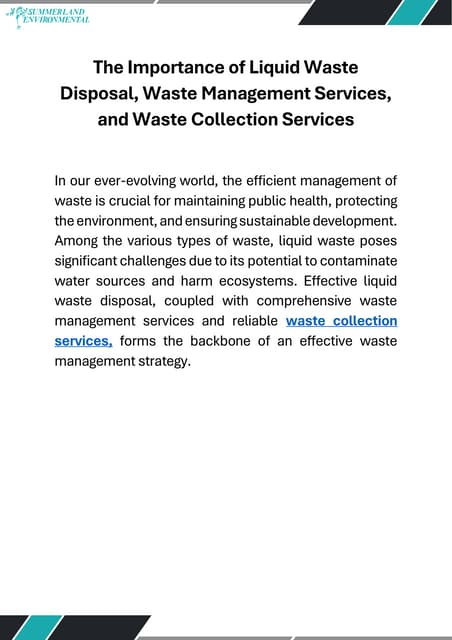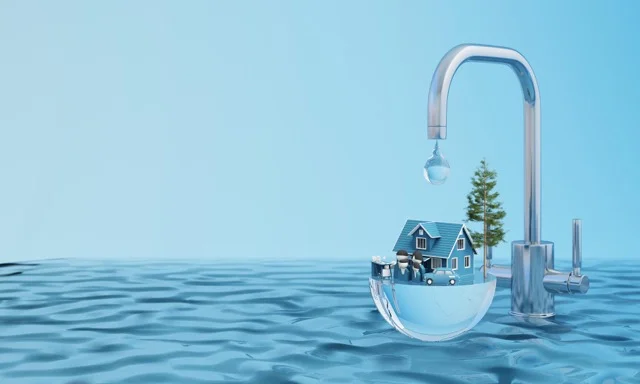Reclaim Waste for Beginners
Reclaim Waste for Beginners
Blog Article
Not known Facts About Reclaim Waste
Table of ContentsExcitement About Reclaim Waste9 Easy Facts About Reclaim Waste ShownThe Reclaim Waste DiariesThe Single Strategy To Use For Reclaim WasteWhat Does Reclaim Waste Mean?
Domestic sewage waste refers to the waste and products from a property septic storage tank. The appropriate monitoring and disposal of residential sewer waste call for liquid waste to be moved to a sewage therapy plant where the proper methods and devices are applied to detoxify and dispose of waste.
Industrial waste typically consists of possible risks, such as flammable materials or a mix of fluid and strong waste products, and needs a more innovative and thorough disposal procedure. The disposal of business waste generally entails the filtration of waste prior to transport to make certain safe and proper disposal. Hazardous waste is created from byproducts and runoff of commercial processes and manufacturing.
This sort of waste can not make use of the same sewage management transport or processes as septic or business liquids. The hazardous waste monitoring procedure calls for the inspection and testing of liquid waste prior to it goes through the disposal process (liquid waste disposal). Drainage waste is the liquid waste that originates from runoff and excess stormwater in extremely inhabited locations or cities
Overflow waste can trigger contamination and flooding if not managed correctly. Making certain appropriate waste management can prevent catastrophes and lower environmental damage.
See This Report about Reclaim Waste
Get in touch with PROS Solutions today to find out about our waste management and disposal solutions and the correct methods to look after the fluid waste you create.
(https://reclaimwaste1.creator-spring.com)This supposed 'wastewater' is not just an essential source but, after treatment, will certainly be launched to our land, rivers or the ocean. Made use of water from toilets, showers, baths, kitchen sinks, laundries and commercial processes is recognized as wastewater.

water used to cool machinery or tidy plant and equipment). Stormwater, a type of wastewater, is drainage that streams from farming and city locations such as roofs, parks, gardens, roads, courses and rain gutters right into stormwater drains, after rainfall. Stormwater moves without treatment directly to regional creeks or rivers, at some point getting to the ocean.
Unknown Facts About Reclaim Waste
In Queensland, a lot of wastewater is treated at sewer treatment plants. Wastewater is transported from domestic or industrial sites through a system of sewage systems and pump terminals, recognized as sewerage reticulation, to a sewer therapy plant. City governments build, maintain and run most sewer therapy plants. Operators are licensed under the Environmental Security Act 1994 to release cured wastewater at an appropriate environmental criterion into waterways.
The Division of Natural Resources recommends city governments about handling, operating and preserving sewage systems and therapy plants. In unsewered areas, local federal governments might require householders to set up individual or household sewage therapy systems to treat residential wastewater from toilets, kitchens, restrooms and laundries. The Department of Natural Resources authorizes making use of household systems when they are verified to be effective.
In some new communities, treatment of some stormwater to eliminate litter, sand and gravel has actually started using gross pollutant traps. Wastewater treatment takes place in 4 phases: Removes solid matter.
Utilizes little living microorganisms recognizes as micro-organisms to damage down and remove continuing to be liquified wastes and great fragments. Micro-organisms and wastes are incorporated in the sludge.
Top Guidelines Of Reclaim Waste
Nutrient elimination is not offered at all sewer therapy plants because it requires expensive specialized devices. Clear liquid effluent generated after treatment might still have disease-causing micro-organisms - liquid waste removal melbourne.

This generally suggests wastewater has actually to be dealt with or pollutants removed before it can be discharged to rivers. Most wastewater flows into the sewerage system. Under the Act, neighborhood governments carry out approvals and licences for ecologically appropriate activities (Ages) involving wastewater releases that could have a neighborhood effect. The division provides approvals and licences to Periods including wastewater releases that may have a regional or statewide effect.
How Reclaim Waste can Save You Time, Stress, and Money.
Monitoring offers factual information about water high quality and can verify that permit conditions are being fulfilled. The details gotten via surveillance provides the basis for making water top quality choices.
Report this page